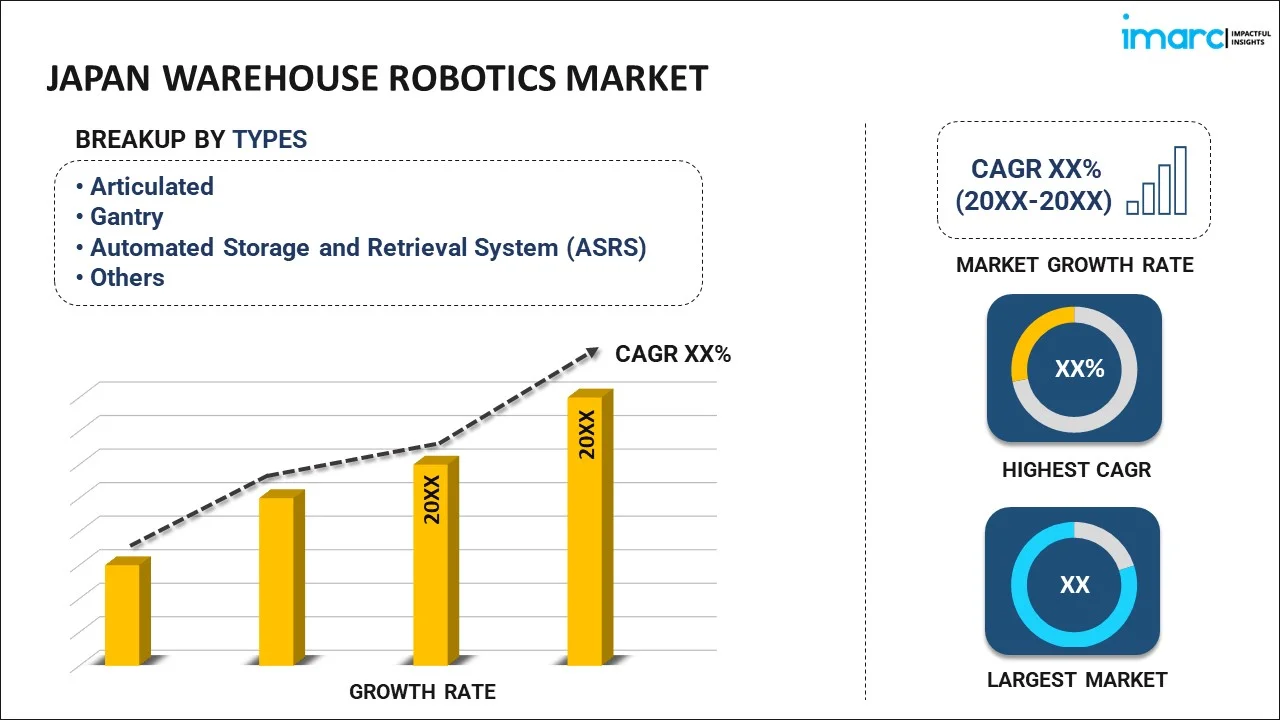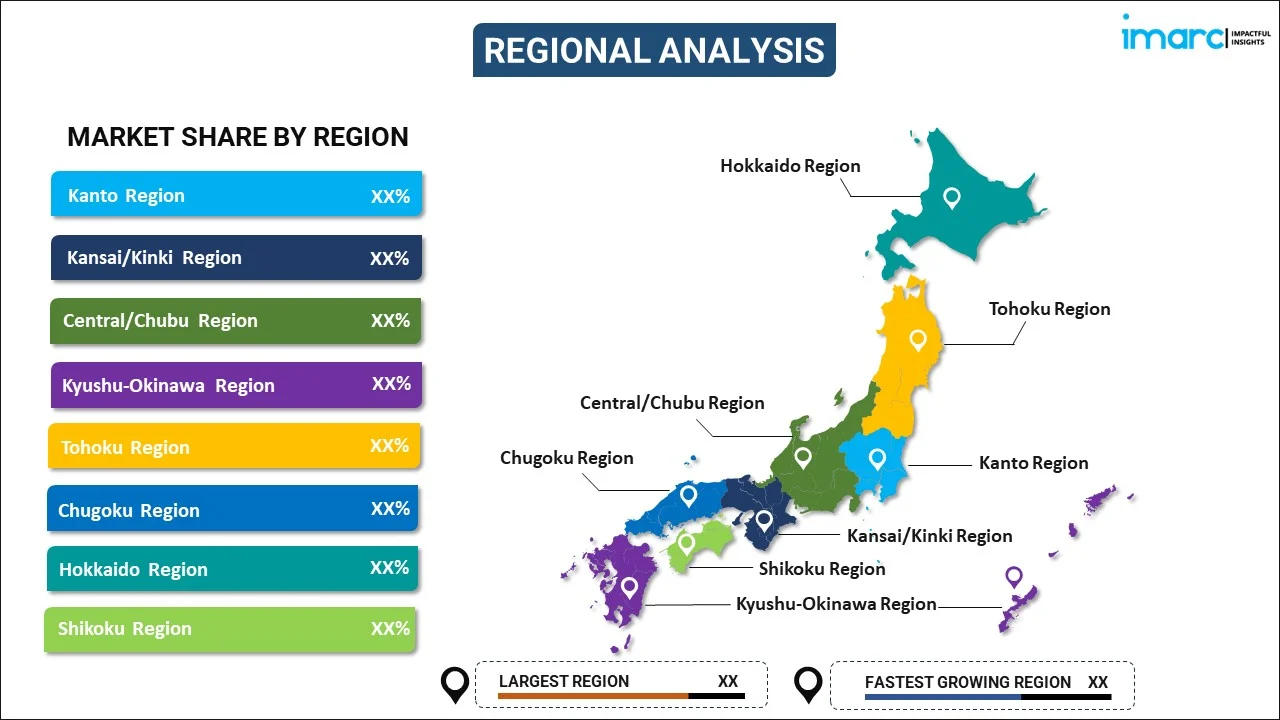
Japan Warehouse Robotics Market Report by Type (Articulated, Gantry, Automated Storage and Retrieval System (ASRS), Mobile, and Others), Function (Storage, Trans-Shipments, Packaging, and Others), End User (Food and Beverages, Automotive, Retail, Electronics and Electrical, Pharmaceuticals, and Others), and Region 2025-2033
Market Overview:
Japan warehouse robotics market size reached USD 414.0 Million in 2024. Looking forward, IMARC Group expects the market to reach USD 1,497.9 Million by 2033, exhibiting a growth rate (CAGR) of 15.4% during 2025-2033. The increasing popularity of robotics technology, including artificial intelligence (AI), computer vision, and machine learning, which have made robots more capable and versatile, allowing them to handle a wider range of tasks in the warehouse, is driving the market.
|
Report Attribute
|
Key Statistics
|
|---|---|
|
Base Year
|
2024 |
|
Forecast Years
|
2025-2033
|
|
Historical Years
|
2019-2024
|
| Market Size in 2024 | USD 414.0 Million |
| Market Forecast in 2033 | USD 1,497.9 Million |
| Market Growth Rate (2025-2033) | 15.4% |
Warehouse robotics refers to the use of automated machines and technology to streamline and optimize various tasks within a warehouse or distribution center. These robots are designed to perform a wide range of functions, including inventory management, order picking, packing, and transportation of goods. They can be autonomous, semi-autonomous, or controlled remotely by human operators. Key components of warehouse robotics include autonomous mobile robots (AMRs) that navigate the warehouse floor, robotic arms for picking and packing, conveyor systems, and automated storage and retrieval systems (AS/RS) that manage inventory. Warehouse robots improve efficiency by reducing labor costs, minimizing errors, and increasing the speed and accuracy of order fulfillment. They also enhance safety by handling repetitive and physically demanding tasks. Overall, warehouse robotics plays a crucial role in modern supply chain management, enabling businesses to meet the growing demands of e-commerce and achieve greater operational efficiency in handling and delivering products to customers.
Japan Warehouse Robotics Market Trends:
The warehouse robotics market in Japan is experiencing robust growth due to a confluence of several key drivers. Firstly, the ever-increasing consumer demand for faster and more efficient order fulfillment has propelled the adoption of warehouse robotics. As a result, e-commerce giants and logistics companies are heavily investing in automation to streamline their operations. Furthermore, the rise of e-commerce has led to a surge in online shopping, intensifying the need for automated warehouses. In addition to this, advancements in technology, such as the development of more sophisticated sensors, machine learning algorithms, and artificial intelligence, have significantly enhanced the capabilities of warehouse robots. These technological breakthroughs enable robots to perform complex tasks with greater precision and adaptability, reducing errors and optimizing inventory management. Furthermore, the regional trend towards sustainability and environmental responsibility, coupled with the widespread adoption of warehouse robotics to reduce energy consumption and minimize carbon footprint, is expected to drive the market in Japan during the forecast period.
Japan Warehouse Robotics Market Segmentation:
IMARC Group provides an analysis of the key trends in each segment of the market, along with forecasts at the country level for 2025-2033. Our report has categorized the market based on type, function, and end user.
Type Insights:

- Articulated
- Gantry
- Automated Storage and Retrieval System (ASRS)
- Mobile
- Others
The report has provided a detailed breakup and analysis of the market based on the type. This includes articulated, gantry, automated storage and retrieval system (ASRS), mobile, and others.
Function Insights:
- Storage
- Trans-Shipments
- Packaging
- Others
A detailed breakup and analysis of the market based on the function have also been provided in the report. This includes storage, trans-shipments, packaging, and others.
End User Insights:
- Food and Beverages
- Automotive
- Retail
- Electronics and Electrical
- Pharmaceuticals
- Others
The report has provided a detailed breakup and analysis of the market based on the end user. This includes food and beverages, automotive, retail, electronics and electrical, pharmaceuticals, and others.
Regional Insights:

- Kanto Region
- Kansai/Kinki Region
- Central/ Chubu Region
- Kyushu-Okinawa Region
- Tohoku Region
- Chugoku Region
- Hokkaido Region
- Shikoku Region
The report has also provided a comprehensive analysis of all the major regional markets, which include Kanto Region, Kansai/Kinki Region, Central/ Chubu Region, Kyushu-Okinawa Region, Tohoku Region, Chugoku Region, Hokkaido Region, and Shikoku Region.
Competitive Landscape:
The market research report has also provided a comprehensive analysis of the competitive landscape in the market. Competitive analysis such as market structure, key player positioning, top winning strategies, competitive dashboard, and company evaluation quadrant has been covered in the report. Also, detailed profiles of all major companies have been provided.
Japan Warehouse Robotics Market Report Coverage:
| Report Features | Details |
|---|---|
| Base Year of the Analysis | 2024 |
| Historical Period | 2019-2024 |
| Forecast Period | 2025-2033 |
| Units | Million USD |
| Scope of the Report | Exploration of Historical and Forecast Trends, Industry Catalysts and Challenges, Segment-Wise Historical and Predictive Market Assessment:
|
| Types Covered | Articulated, Gantry, Automated Storage and Retrieval System (ASRS), Mobile, Others |
| Functions Covered | Storage, Trans-Shipments, Packaging, Others |
| End Users Covered | Food and Beverages, Automotive, Retail, Electronics and Electrical, Pharmaceuticals, Others |
| Regions Covered | Kanto Region, Kansai/Kinki Region, Central/ Chubu Region, Kyushu-Okinawa Region, Tohoku Region, Chugoku Region, Hokkaido Region, Shikoku Region |
| Customization Scope | 10% Free Customization |
| Post-Sale Analyst Support | 10-12 Weeks |
| Delivery Format | PDF and Excel through Email (We can also provide the editable version of the report in PPT/Word format on special request) |
Key Questions Answered in This Report:
- How has the Japan warehouse robotics market performed so far and how will it perform in the coming years?
- What has been the impact of COVID-19 on the Japan warehouse robotics market?
- What is the breakup of the Japan warehouse robotics market on the basis of type?
- What is the breakup of the Japan warehouse robotics market on the basis of function?
- What is the breakup of the Japan warehouse robotics market on the basis of end user?
- What are the various stages in the value chain of the Japan warehouse robotics market?
- What are the key driving factors and challenges in the Japan warehouse robotics?
- What is the structure of the Japan warehouse robotics market and who are the key players?
- What is the degree of competition in the Japan warehouse robotics market?
Key Benefits for Stakeholders:
- IMARC’s industry report offers a comprehensive quantitative analysis of various market segments, historical and current market trends, market forecasts, and dynamics of the Japan warehouse robotics market from 2019-2033.
- The research report provides the latest information on the market drivers, challenges, and opportunities in the Japan warehouse robotics market.
- Porter's five forces analysis assist stakeholders in assessing the impact of new entrants, competitive rivalry, supplier power, buyer power, and the threat of substitution. It helps stakeholders to analyze the level of competition within the Japan warehouse robotics industry and its attractiveness.
- Competitive landscape allows stakeholders to understand their competitive environment and provides an insight into the current positions of key players in the market.
Need more help?
- Speak to our experienced analysts for insights on the current market scenarios.
- Include additional segments and countries to customize the report as per your requirement.
- Gain an unparalleled competitive advantage in your domain by understanding how to utilize the report and positively impacting your operations and revenue.
- For further assistance, please connect with our analysts.
 Inquire Before Buying
Inquire Before Buying
 Speak to an Analyst
Speak to an Analyst
 Request Brochure
Request Brochure
 Request Customization
Request Customization




.webp)




.webp)












